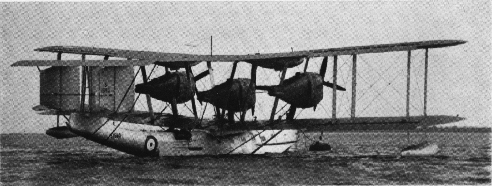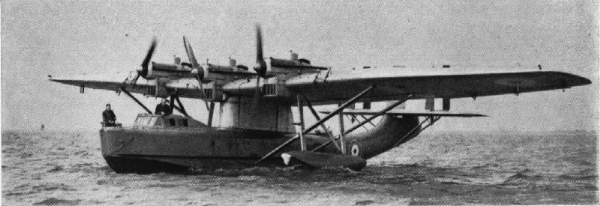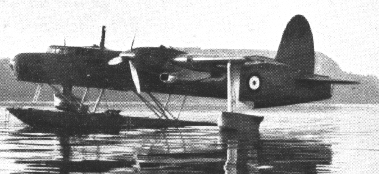

The development of British military flying boats between the wars was closely interwoven with that of their civilian counterparts and dominated by the Supermarine and Shorts companies. The military boat picture in the mid twenties was completed by Saunders and Blackburn all of whom were destined for leading roles in the future.
Blackburns had entered the boat business under the capable leadership of J. D. Rennie and started by resurrecting the hull design of their little single seat pre first war N1B flying boat which was completed as the Pellet racer for the 1923 Schneider Trophy. It was not a great success, crashing on its first take off!
| IRIS III prototype (N238) at
moorings in 1927. Powered by three 650hp RR
Condor IIIA engines, all metal construction wings
fabric covered. Delivered to RAF No 209 squadron in 1929 and based at Mount Batten, Plymouth, a total of 4 were built. Five man crew, Lewis guns in open positions bow, tail and midships, 2000 lb bomb load. |
 |
The next Blackburn design, which first flew in 1927, was a three engined wooden hull design, named the Iris. It proved to be much more successful, however a revolutionary method of construction in aluminium perfected by Shorts, rendered all the wooden boats of the time virtually redundant.
Within months of the Shorts Singapore flying, a metal hulled version of the Iris was accepted for service with the RAF, and with new metal flyingboats from Supermarine and Saunders Roe, it heralded the start of an era of great flights by RAF flying boats units. One such flight concerned an Iris II used for a tour of Scandinavia by the Secretary of State for Air and proving so comfortable and efficient that the same machine was chosen in 1928 for two month tours of Mediterranean and Indian air stations.
 Blackburn Iris Mk III |
Blackburns took their Iris design through an all metal mk.III version and on to mks IV and V which were fitted with three Armstrong Siddereley Leopards and three Rolls Royce Buzzards respectively. The Iris VI paved the way for the formidable Perth in 1933 which proved to be the largest biplane flying boat to serve with the RAF. Only four Perths were built.
In 1930 an monoplane development of the Iris was the Blackburn Sydney, which was years ahead of its time and the RAF's first big multi engined monoplane boat. It was based on the abandoned Nile project for a civilian monoplane. Only one was delivered for RAF service.
 Blackburn Sydney |
In 1940 Blackburn completed the B20 as a solution to overcome the inherent problems of propeller driven flying boats ie keeping the blades well clear of the water spray during takeoff and landing and increasing the angle of wing incidence enabling take off from water.
The Blackburn solution was based on a patented concept developed some years earlier by Blackburns chief seaplane designer Major J. D. Rennie. It took the form of a retractable planing hull which extended to give the aircraft the effect of a conventional aeroplane mounted on a central float. Stability on the water was provided by retractable wing tip floats. In the air the hull retracted to a flush fit with the fuselage while the floats formed well shaped wing tips. Only one B20 was completed as design and development work was abandoned due to pressure from urgent wartime requirements and the loss of the prototype during a test flight.
| BLACKBURN B20 -Two 1720hp RR Vulture 24 cylinder X type engines. |  |
 |
The
B20 had a maximum speed of 322 mph and an
estimated range of 1500 miles. Armament consisted of 8 machine guns and eight 250 lb bombs. |
The B20 had demonstrated satisfactory handling qualities on water and in the air. Accommodation was provided for a crew of seven and included sleeping quarters for 6, a wardroom, engineers workroom, galley and toilet.
23 Oct 98